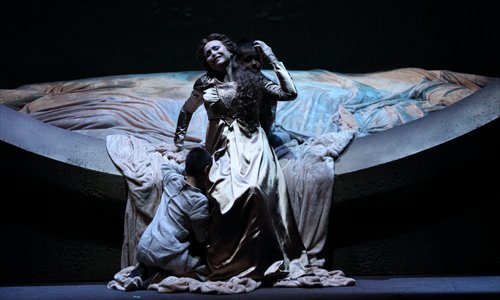

Rachele Stanisci (Center)plays the lead role in Norma at the NCPA on Thursday. Photo: Courtesy of NCPA
The early 19th century was the era of bel canto. Following the classical master Mozart, yet before the later genius of Wagner and Verdi, the times stood witness to three outstanding musicians: Rossini (1792-1868), Donizetti (1797-1848) and Bellini (1801-35). While works by the former two have previously been presented in China, such as L'Elisir d'Amore and Barbiere di Siviglia, it wasn't until this month that the complete version of the latter's opera, Norma, finally debuted in China.
Performed at the National Centre for the Performing Arts in Beijing from Thursday to Sunday, the performance was divided among two teams, with the A team, the leads played mainly by overseas performers, performing on Thursday and Saturday, and the B team, mainly local performers, performing on Friday and Sunday.
Greek style tragedy
The story of Norma takes place in 50 BC, after Gaul fell under Roman occupation. Norma, the high priestess of a group of druids, has had a secret affair with their enemy, the Roman proconsul Pillione, giving birth to two sons. For this reason, she has continually prayed for peace and kept her people from going to war.
However, Pillione betrays Norma by seducing the young novice druid priestess Adalgisa. After Pillione persuades Adalgisa to run away with him, Adalgisa goes to Norma to renounce her vows with their god, ignorant of her beloved leader Norma's relationship with Pillione. Due to her own experiences with love, Norma shows mercy and understanding at first, but then she finds that the man they love is the same person. At this point Pillione appears and confesses his love for Adalgisa, which angers Norma.
Feeling betrayed by the man she loved, Norma urges her people to attack the Romans in revenge and threatens Pollione that she will execute Adalgisa and their children. However, in the end she realizes that she too is guilty for breaking her vows as a priestess and chooses to be burned at the stake for her crimes. Pillione, moved by her nobility, decides to enter the pyre with her together.
Norma received high praise from some critics in China for successfully presenting the complicated humanity of its heroine. "The greatest creator of this opera is the script writer rather than the composer. He made an opera with the grandeur of Shakespeare and the elegance and power of an ancient Greek tragedy," Wang Bin, a critic, wrote on his Weibo account after watching the opera.
Stage design also contributed greatly to the success of the performance. The round moon and the sets depicting night scenes symbolized the female lead of the story. Giant shields shaped like the full moon, implied that behind the gentle moonlight and this woman's love, lay something strong and full of power. Meanwhile, the naturalistic and bourgeois house set presented the profound loneliness and isolation of the heroine.
"I conceived the circular shape that characterizes the scene, in addition to calling to mind the shield and therefore the war that hangs over the future of Norma, like a great mirror of the unconscious… I brought forth to the 'sorceress' Norma the visions of the tragedy to come, the images of fire, war and infanticide," wrote director Pier'Alli, a former architect major, in the opera's program.
Les Ballets de Monte-Carlo LAC
2013-10-08Copyright ©1999-2018
Chinanews.com. All rights reserved.
Reproduction in whole or in part without permission is prohibited.